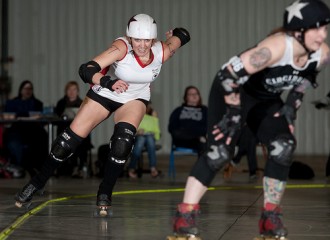Roller Derby Renaissance
Roller derby, as it was played in the days of Maw Bogash and Toughie Brashun, continued for several years before waning audiences caused it to fold in 1972. A brief, and misguided, attempt to revive the sport in 1986 was ABC’s Rock-n-Roller Games, which involved a figure-8 track, “Wall of Death,” and live alligator pit. From 1999 to 2001, the show RollerJam aired on The Nashville Network (TNN), featuring roller derby played on roller blades instead of quad skates. The ratings were low, however, and the show never gained recognition.
The year that Rollerjam went off the air saw a rebirth of roller derby. The modern incarnation of the sport was born in an Austin bar as approximately 100 women met for the first time to discuss a new, women-only roller derby league. This beginning led to two leagues, one playing on a traditional banked track and the other on the flat track. The flat-track leagues have taken off like wildfire, due in large part to the ease with which flat tracks can be constructed and relocated. The Women’s Flat Track Derby Association (WFTDA) currently has 130 full member leagues and 71 apprentice leagues.

Today, roller derby is growing by leaps and bounds. New leagues are springing up all over the country and leagues that have been around for several years are pushing the sport to new levels of athleticism and strategy. The days of showmanship and brawling are rapidly disappearing. There are still plenty of blocks thrown, tumbles taken, and injuries suffered, but now the sport is governed by a strict set of rules and enforced by league referees. The women of roller derby are athletes that train and work as hard as athletes in any other sport. While many teams still incorporate short shorts, make-up, and roller derby noms de guerre, just a few minutes at any bout will show you that this new incarnation of the sport is all about athleticism. In an effort to further promote the sport’s commitment to strong athletics, the members of some teams have begun playing under their legal, given names and in standardized uniforms.
Members and apprentice leagues of the Women’s Flat Track Derby Association play by WFTDA rule sets and are refereed by WFTDA trained officials. An international rule set has been drawn up by USA Roller Sports (USARS), which is recognized as the national governing body of roller sports by the U.S. Olympic Committee and the International Roller Sports Federation. As the national governing body, USARS is the only organization that can petition for the sport to be entered into the Olympics, a goal they are currently working toward with roller sports already on the short list for inclusion in the 2020 games.
Meanwhile, banked track derby still attracts a large following and plays by a rule set created by the American Roller Skating Derby Association and the Bay City Bombers of California.

If you’re missing the days of no-holds-barred, rough-and-tumble derby, you’ll find it at a Renegade Derby league, whose no-rules philosophy encourages playing at any time, on any surface. For those interested in the sport but hesitant to sign up for the tumbles and falls, there’s also Derby Lite, an organization that promotes physical fitness and roller derby skills without the impact or competition found in league play.
The game has evolved greatly in the last decade. The increase in regulations and rules have turned a wild, fast sprint around the track into a thoroughly strategized and competitive sport that forces teams to continually improve their tactics and skill level.
Women still dominate the flat track sport, dedicating hours every week to a sport they play out of choice rather than the desperation driven by the Great Depression.
Every year, teams from across the country compete in regional tournaments for a chance at the national title.
Roller Derby is spreading across the world as well, with leagues now active in over 35 countries. December 2011 saw the first Roller Derby World Cup, in Toronto, Canada, with teams from the USA, United Kingdom, European Union, and South America.
For a quick guide to the rules of modern derby as played by WFTDA leagues, watch this video, courtesy of the Naptown Roller Girls of Indianapolis, IN:
And catch a glimpse of flat track roller derby in action with this video of the Naptown Roller Girls filmed during the Northwest Central Region “Monumental Mayhem” Tournament, held in October 2011:
Since its revival in 2001 the sport has continued to attract women by offering them a unique arena to express their athleticism and inner rebel. The evolving sport represents both empowerment and opportunity, not only for those that participate, but for fans, spectators, and volunteers as well.
Special thanks to Strawberry Jam and CacaFuego of the Naptown Roller Girls, Beattie Sedgwick of the Circle City Derby Girls, and Craig Bailey of the Charlotte Speed Demons for their thoughtful input.